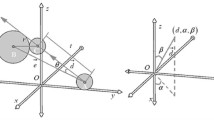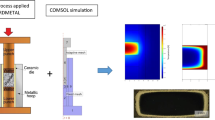Simulation modeling results for powder mixtures comprised of saponite and stainless steel powders are presented. A literature review focusing on methods for modeling the filling and production of powder materials in technological processes was conducted. Computer modeling employed to examine the behavior of particulate mixtures in two-dimensional and three-dimensional planes, considering their volumetric characteristics, was studied theoretically. The properties of AISI430 steel and saponite powders, such as grain-size composition and sphericity factors, were studied experimentally. The density of workpieces made from steel and saponite powders for modified and unmodified powder particles was calculated as percentage. A method for calculating the distribution of particles and determining the density of workpiece layers using the ImageJ2x software was proposed. Image stacks were generated and image series were analyzed using object mask functions and threshold and image inverter brightness threshold functions. The processed microscopy data enabled the determination of void percentage within the visible areas of the samples. A simulation model was proposed to describe the formation of powder materials with varying geometries and sphericity. The process of filling a cylindrical container with the powder mixture was simulated. A 3D computer model was developed to visualize the formation of a two-component powder mixture using the Blender 3D application software. Maps depicting the distribution of powder particles in selected planes were constructed.





Similar content being viewed by others
References
Eric Parteli and Thorsten Pöschel, “Particle-based simulation of powder application in additive manufacturing,” Powder Technol., 288, 96–102 (2015).
Yi He, Ali Hassanpour, and Andrew E. Bayly, “Linking particle properties to layer characteristics: Discrete element modelling of cohesive fine powder spreading in additive manufacturing,” Addit. Manuf., 36, 1–15 (2020).
Yifei Ma, T. Matthew Evans, Noah Philips, and Nicholas Cunningham, “Numerical simulation of the effect of fine fraction on the flowability of powders in additive manufacturing,” Powder Technol., 360, 608–621 (2020).
Mujian Xia, Nianlian Li, Man Zhang, Donghua Dai, Yuebin Lin, Aihui Liu, Xiaogang Chen, and Hongyan Ding, “Multi-material model for mesoscopic analysis of porosity evolution during laser powder-bed fusing TiNbTa powder mixture,” Comput. Mater. Sci., 198, 124–137 (2021).
A.Yu. Andreytsev, I.V. Smirnov, A.V. Chornyi, and S.M. Minakov, “Modeling the spheroidization of powder particles by the arc plasma method,” Prikl. Pyt. Mat. Model., 4, No. 2.2, 25–33 (2021).
V.D. Rud, G.A. Baglyuk, T.N. Galchuk, and O.Yu.Povstyanoy, Technological Processes for Disposing Machine Building Production Waste: University Textbook [in Ukrainian], Red. Vyd. Lutsk Derzh. Tekh. Univ., Lutsk (2015), p. 296.
B. Suhr and K. Six, “Simple particle shapes for DEM simulations of railway ballast: influence of shape descriptors on packing behavior,” Granular Matter, 22, 43–60 (2020).
V.D. Rud, N.A. Khrystynets, and N.T. Rud, “Vibrational modeling of filtering materials using stainless steel and saponite powders,” Powder Metall. Met. Ceram., 58, No. 11–12, 623–630 (2020).
N.A. Khrystynets and V.D. Rud, “Use of stainless steel and saponite sludges in the formation of gradient materials,” in: Proc. First Int. Sci. Tekh. Conf. Prospects of Machine Building and Transport Development 2019 [in Ukrainian], Vinnytsia (2019), pp. 271–273.
T.G. Collins, “ImageJ for microscopy,” BioTechniques, 43, No. 1S, 25–30 (2007).
N.A. Khrystynets, Theoretical and Experimental Study of Vibrational Segregation Parameters in the Development of Permeable Gradient Materials [in Ukrainian], Author’s Abstract of PhD Thesis in Technical Sciences, Lutsk (2021), p. 24.
Y. Jiao and S. Torquato, “Maximally random jammed packings of platonic solids: hyperuniform long-range correlations and isostaticity,” Phys. Rev. E, 84, 1–15 (2011).
Xingcai Li, “Equivalent medium theory of layered sphere particle with anisotropic shell,” J. Quant. Spectrosc. Radiat. Transfer, 179, 165–169 (2016).
Author information
Authors and Affiliations
Corresponding author
Additional information
Translated from Poroshkova Metallurgiya, Vol. 61, Nos. 9–10 (547), pp. 35–45, 2022.
Rights and permissions
Springer Nature or its licensor (e.g. a society or other partner) holds exclusive rights to this article under a publishing agreement with the author(s) or other rightsholder(s); author self-archiving of the accepted manuscript version of this article is solely governed by the terms of such publishing agreement and applicable law.
About this article
Cite this article
Rud, V.D., Khrystynets, N.A. Simulation Modeling of Forming Processes for Powder Mixtures. Powder Metall Met Ceram 61, 514–521 (2023). https://doi.org/10.1007/s11106-023-00341-0
Received:
Published:
Issue Date:
DOI: https://doi.org/10.1007/s11106-023-00341-0




